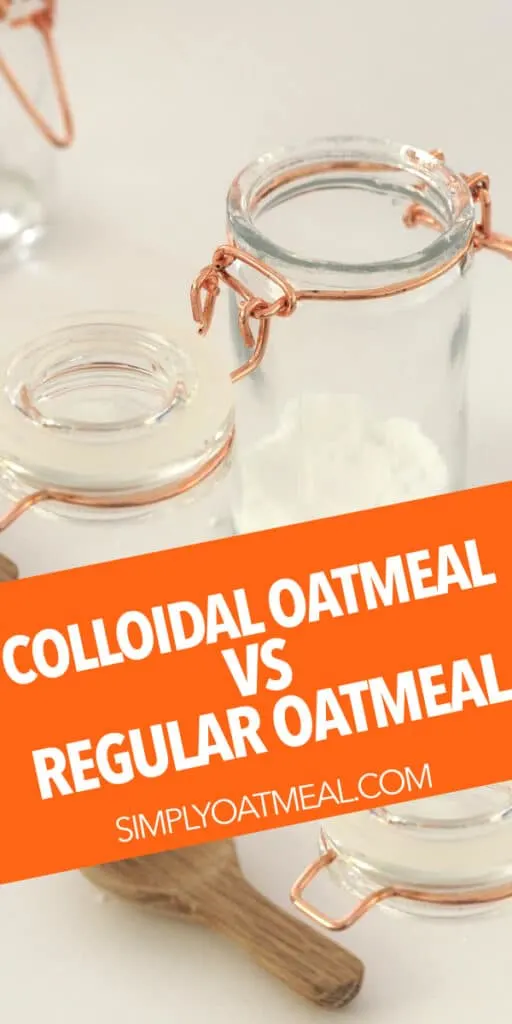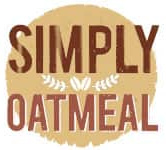Colloidal oatmeal and regular oatmeal are both good for you and offer a wide range of health benefits. Both are made from oats, but how are they different?
Is regular oatmeal that you eat for breakfast the same as colloidal oatmeal? No, colloidal oatmeal is an anti-inflammatory topical salve that is commonly used in beauty products and applied to soothe irritated skin. Regular oatmeal comes in many forms and is used in porridge, overnight oats, pancakes, baked goods and much more.
When both of types of oats are ingested, they provide enhanced effects that spread throughout the body. However, colloidal oatmeal is ingested by the skin and you are not supposed to eat it.
This article will cover the major differences between regular oatmeal and colloidal oatmeal. Detailed below are the benefits, uses and how to prepare the oat preparations, to learn about the differences please continue reading.
What is a colloidal oatmeal?
Colloidal oatmeal is an aqueous solution of finely ground oats and water. The salve is rich in plant compounds, fats, proteins, vitamins and mineral that are known to reduce skin inflammation, soothe irritated areas and provide hydrating moisture.
For centuries now, it has been used to treat irritated, dry or itchy skin. You can apply it directly onto the affected area or take a bath in it.
The natural ingredient is readily seen in various cosmetic products like shaving creams, shampoos and moisturizers.
For preparing it you will need to grind oat grains into an ultra fine powder like texture.
Experts consider it to be an emollient, which means it is a substance that can soothe or soften the skin. This is possible because it is rich in vitamins, minerals, fats, proteins and other plant chemicals that are known to be beneficial for the skin.
Oats are known for their antioxidant properties, which aid in fighting free radicals. If the numbers of free radicals become too high, it can damage your body through oxidative stress.
Oxidative stress is linked to certain conditions such as heart disease, diabetes, cancer and inflammation and certain skin diseases like dermatitis. It can also affect aging by cutting the supply of moisture and elasticity to the skin.
So, colloidal oatmeal is useful to combat these skin irritations and
What does colloidal mean?
Colloidal system or colloidal solution or simply, colloidal can be explained as a mixture where microscopic dispersed insoluble particles of one substance are mixed in with another substance. The size of the suspended particles in such a mixture can range from 1 to 1000 nanometers and represent a small number of parts per million.
A substance is split into very minute particles, and then dispersed throughout a second substance, so it happens to be heterogeneous in nature. Colloidal oatmeal is a mixture of fine powered oats and water.
Colloidal oatmeal is known to be processed from whole oats and includes the bran. Compared to the oatmeal you have for breakfast, these oats happen to be ground it fine powder that is smaller in particle size. By using a blender, food processor or coffee grinder, you can grind rolled oats into a fine power to make colloid in at home.
How is colloidal oatmeal different from regular oatmeal?
In reality, dry colloidal oatmeal looks very similar to oat flour. Yes, it can be eaten, but it is not consumed on the same frequency as regular oatmeal.
Regular rolled oats are a whole grain dry good, whereas colloidal oats are finely ground into powder and then mixed with a liquid base to make a salve.
To prepare regular oats you need to boil the oat in hot water. On the other hand, preparing colloidal oatmeal requires soaking fine powder of oatmeal in lukewarm water.
Colloidal oats act as a natural emollient that is applied topically. It contains fatty acids, lipids, enzymes, polysaccharides, proteins, saponins and vitamin E.
A bowl of regular oatmeal can be made with any kind of oats, which typically include steel cut oats, rolled oats and quick oats that you ingest to enjoy all the benefits oats have to offer. The exterior husk of the oat grain is removed, and then the kernel is processed into the different kinds.
Rolled oats are steamed, rolled and pressed into thinner flakes, while steel cut oats are the oat groats cut in half.
Store oatmeal for a longer shelf life as you can use regular oatmeal in many different ways. In general, a bowl of oatmeal or overnight oats contains around 150 calories, 4 grams of fiber and 5 grams of protein.
Can colloidal oatmeal be eaten?
Dry colloidal oatmeal can be eaten if it is pure oat flour. However, it is typically combined with a liquid to create a variety of beauty products including salve, creams ointments or cleansers, which are not safe to eat.
Beauty products containing colloidal oats are meant to be used topically.
To make grind the oats into powder, add uncooked rolled oatmeal to a coffee grinder, food processor or blender. Blend for 30 to 60 seconds to get off-while colored fine power.
To ensure that it is properly ground, check the consistency by adding 1 tablespoon of the powder to a pint of water. If the water turns milky white, then you do not need to grind in further.
You can even make colloidal oatmeal bath water. To prepare an oatmeal bath, add 1 cup of colloidal oat powder to a bath full of lukewarm water and soak in the mixture for 10-15 minutes.
Can you use regular oatmeal for body care?
Applying regular oatmeal for body care does not have the same affect as colloidal oats. To use regular oats, they must be cooked and cooled or soaked in water for several hours to make a mush that can be applied to the surface of the skin as a mask or pack.
Colloidal oatmeal provides the best results for body care. The oats are a finely ground powder that is spreadable and absorbs nutrients into the skin much easier.
Having said that, if you ingest oatmeal on a regular basis, then you are bound to get some major benefits as well.
Oatmeal has many different nutrients including iron, copper, zinc, phosphorus, manganese, magnesium, folate and Vitamin B5 (pantothenic acid) and B1 (thiamin). It also contains beta-glucan, which can reduce cholesterol and blood sugar levels.
When consumed regularly, oats can even make you feel full, encourage weight loss, promotes healthy gut bacteria, relieve constipation and aid in digestion. But again, this is when the regular oats are consumed.
Is colloidal oatmeal good for body care?
For centuries, colloidal oatmeal has been used for soothing itchy, dry and irritated skin. Besides antioxidants, oats contains an anti-inflammatory plant chemical, known as avenanthramides, that can boost overall health and aggravated skin conditions.
Colloidal oats are known to treat eczema caused by stress, irritants and allergies. Skin dryness and irritation caused by radiation treatment for cancer can be treated with a solution of colloidal oatmeal and water.
Xerosis is common during the colder months of winter, although it could be caused by exposure to harsh chemicals as well. It can be treated with a simple oatmeal salve that may also help alleviate burn-related itching and itching caused by chickenpox.
Can you use colloidal oatmeal every day?
If the colloidal oatmeal is in form of a skin moisturizer, then you can use it two times a day, every day. You can even take bath in such solution every day to soothe your skin.
It is used to soothe common inflammatory conditions such as psoriasis, rosacea, eczema, acne, poison ivy and more. Thus, applying it every day may actually benefit you.
You can either use products that have it as an ingredient, or you can make your own and use it as needed. When used daily, it is known for protecting the skin against environmental pollutants while nourishing and moisturizing with essential nutrients.

Colloidal Oatmeal vs Regular Oats: Final Thoughts
Both colloidal oatmeal and regular oatmeal are beneficial for regular usage. So, next time you face any problems that can be solved by these two types of oatmeal preparation, it is highly advisable that you take its help to get relief.
Colloidal oats are finely ground into powder, similar to oat flour, that is mixed into lotions, creams, shampoos, salves and many other beauty products. The topical applications are meant for external usage, and not intended to be eaten.
On the other hand, regular oatmeal is used for consumption. Oats make a delicious porridge, cereal, pancakes and a wide range of baked goods.
You can add regular oats to a lukewarm bath or make a thick mush that can be applied to the face or skin as a moisturizing mask. Colloidal oats are raw and unadulterated, therefore the ground powder offers more complete nourishment to the skin as opposed to applying a cooked mixture that has the nutrients slightly degraded.
Now you know the difference between regular oatmeal and colloidal oatmeal. Although they both can be eat, when 100% pure and free of contaminants, regular oats are used primarily for food and ground colloidal oats are mixed into beauty products to nourish the skin.
